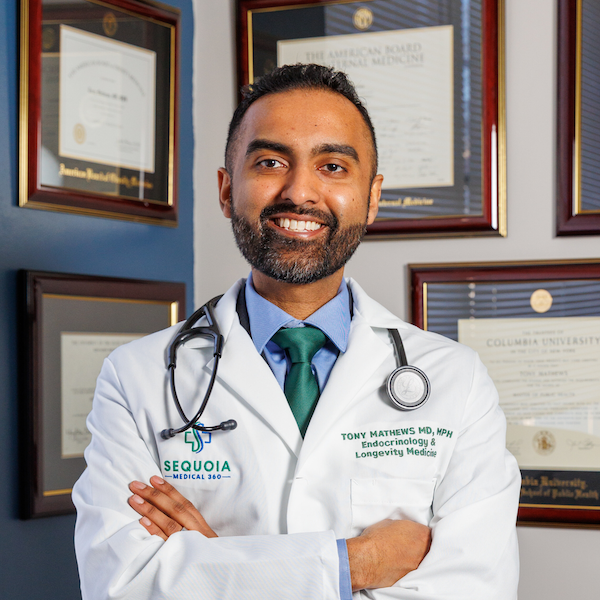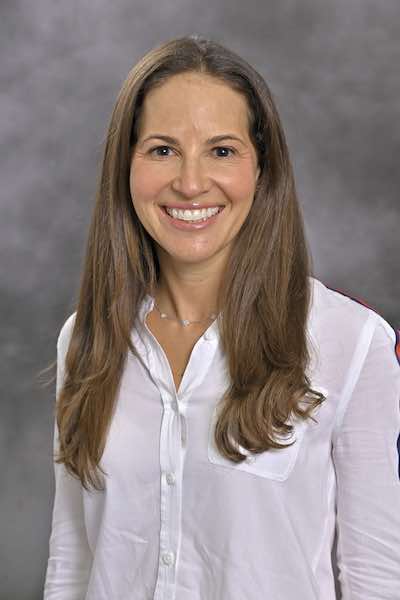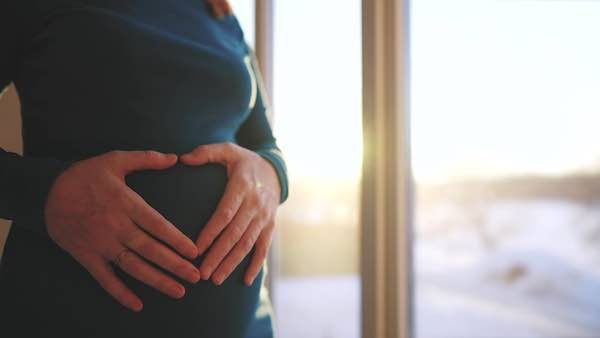Live Long, Stay Strong: 10 Health Commandments
- Details
- Written by: Tony Mathews, MD, MPH.
- Category: Health
 The Blueprint for Living Long and Staying Strong Is Simple—But Not Easy
The Blueprint for Living Long and Staying Strong Is Simple—But Not Easy
Dr. Tony Mathews is an Endocrinologist and Longevity Medicine Specialist with fellowship training in Endocrinology and Preventive Cardiology. He is board certified in Internal Medicine, Endocrinology, Clinical Lipidology, and Obesity Medicine, with over 12 years of experience. For the past three years, he has been honored to serve this community—helping people like you live longer, healthier lives by preventing and managing chronic disease.
Mathews explains, "I have found that we all want more than just a long life—we want a healthy one. We want to feel vital, strong, and full of purpose for as long as possible. This is the concept of healthspan, and it's what drives my personal commitment to wellness."
"These are the 10 Health Commandments I strives toward every day to build a longer, stronger life—principles he hopes will guide you on your own journey."
1. Fuel Wisely: Eat Real Food – Think Apple, Not Apple-Flavored Snack
What you eat becomes who you are. Pick an evidence-informed nutritional style that works for you. Prioritizing whole, unprocessed foods like fruits, vegetables, lean proteins, and whole grains provides the essential nutrients, fiber, and energy needed for optimal function and disease prevention. Support a healthy gut microbiome by including fiber and fermented foods in your diet.
2. Hydrate Intelligently: Drink More Water – Your Body Craves It
Your body is over 60% water. Every cell, tissue, and organ in your body needs water to function properly. Proper hydration aids digestion, nutrient absorption, temperature regulation, waste removal, and even cognitive performance. Make water your go-to beverage throughout the day and aim for 6–8 cups daily. Minimize sugar-sweetened beverages.
3. Strengthen Your Heart & Lungs: Keep the Engine Running
Move as much as possible each day. Aim for at least 150 minutes of moderate-intensity aerobic exercise—like brisk walking, cycling, or swimming—or 75 minutes of vigorous-intensity activity per week. Include high-intensity interval training, especially when you're short on time.
4. Build & Maintain Muscle: Your Foundation to Carry You Through Life
You can lose up to 40% of your muscle mass between ages 30 and 70. It’s easier to build muscle today than it will be tomorrow. Incorporate resistance training 2–3 times a week to build muscle today and maintain it tomorrow—your future mobility and independence depend on it.
5. Champion Rest and Recovery: Sleep Is Your Body’s Reset
Sleep is not a luxury; it’s a biological necessity. During sleep, your body undergoes critical repair processes, consolidates memories, and regulates hormones. Aim for 7–8 hours of quality sleep each night. Sleep consistency is just as important as duration, so try to go to bed and wake up at the same time every day.
6. Do No Harm: Avoid Known Toxins
Smoking remains a leading cause of preventable death and disease. If you smoke, there are many resources to help you quit. Similarly, while moderate alcohol consumption may be acceptable for some, excessive intake can harm your liver, brain, and significantly increase your risk of cancer.
7. Cultivate Stress Resilience: Teach Yourself to Bounce Back
Chronic stress can negatively affect nearly every system in your body. While stressors are an inevitable part of life, developing resilience helps you adapt and recover. Practices like mindfulness, deep breathing, journaling, and spending time on hobbies can significantly boost your ability to cope effectively.
8. Nurture Your Mind: It Is Your Greatest Asset
Your mental health is deeply linked to your physical health. Take proactive steps to care for your emotional and psychological well-being. This includes practicing self-compassion, acknowledging your feelings without judgment, and engaging in activities that bring you joy. Keep your mind sharp with new skills, creative pursuits, and meaningful conversation—and recognize when professional support may be helpful.
9. Connect for Longevity: Forge Strong Social Bonds
Humans are wired for connection. Meaningful relationships offer emotional support, reduce loneliness, and can even improve physical health and longevity. Make an effort to nurture existing relationships and cultivate new ones by joining groups, volunteering, or simply reaching out to friends and family.
10. Reconnect with Nature: Find Your Outdoor Sanctuary
Spending time outdoors has been shown to reduce stress, improve mood, and increase physical activity. Whether it’s a walk in a local park, tending a small garden, or taking a weekend hike, make time to connect with the natural world. Even short, regular exposure to nature offers real benefits.
Let’s Build Your Healthspan Together
Ready to take the next step on your path to a longer, stronger life? Discover proactive health and longevity care with Dr. Tony Mathews and the team at Sequoia Medical 360—Your Partner In Proactive Health.
Dr. Tony Mathews is a Dual Fellowship-Trained, Quadruple Board-Certified Endocrinologist and Longevity Medicine Specialist with over 12 years of experience, who has spent the past 3 years serving our local community.
Sequoia Medical 360 is a Concierge Medical Practice based out of Bronxville and serves the Westchester community.
Call 914-292-0300 today and take the first step toward a healthier, stronger future—right here at home.
Finding Your Perfect Match: How to Choose an OB-GYN for Your Pregnancy Journey
- Details
- Written by: Joanne Wallenstein
- Category: Health
 Submitted by Dr. Nabil Khoury, OB/GYN at White Plains Hospital
Submitted by Dr. Nabil Khoury, OB/GYN at White Plains Hospital
Choosing an OB-GYN for your pregnancy journey is an important step for new parents.
“The birth process is a very personal and private matter, so patients need someone who is knowledgeable and will build trust with the family,” says Dr. Nabil Khoury, an OB-GYN with White Plains Hospital Physician Associates who has been practicing in the region for more than 27 years. He offers this advice:
Ask around
Talk to a trusted healthcare provider whom you respect to see if they have any recommendations. Family and/or friends who have had a positive experience with their OB-GYN can be another avenue to finding the right provider. OB-GYN physicians who deliver at White Plains Hospital can also be found online at wphospital.org.
Look for a provider who is reassuring
“With any pregnancy, it’s normal to feel fear of the unknown. An important part of your OB-GYN’s role is to reassure patients, educate them and carry them through the whole process,” Dr. Khoury says.
Seek a collaborative experience
Dr. Khoury feels the team approach at White Plains Hospital, which offers Maternal-Fetal Medicine (MFM) physicians who work in conjunction with your own OB-GYN, is a real benefit for patients. By collaborating, the team can conduct genetic testing in the preconception period and throughout the pregnancy. They also have the ability to treat high-risk patients or complicated pregnancies, working towards a healthy outcome for both mom and baby.
Dr. Khoury and his team are also able to access other services from the Hospital if needed. For example, if a woman is anemic during pregnancy and needs an iron infusion, Dr. Khoury’s office will call the hematology department at the Hospital and and make sure that she will be seen in a timely fashion. “If a problem arises, we take care of it and put the mother in touch with the specialist she needs to see. If a patient calls us with a need for an appointment or a question, we are accessible and can facilitate that appointment as soon as possible,” he explains.
Learn more about the Maternal Healthcare Services available at White Plains Hospital.
Dr. Nabil Khoury is an OB-GYN with White Plains Hospital Physician Associates who has been practicing in the region for more than 27 years. To make an appointment, call 914-328-8444.
 Health Matters
Health Matters
The original version of this article was published in Health Matters, a White Plains Hospital publication.
Tastes Like Summer: Grilled Shrimp Tacos with Peach Salsa
- Details
- Written by: Joanne Wallenstein
- Category: Health
 This article was submitted by Kimberly Greenburg, MS, Nutritionist with White Plains Hospital
This article was submitted by Kimberly Greenburg, MS, Nutritionist with White Plains Hospital
Summer is the perfect time to pack your plate with fresh fruits and vegetables that are both healthy and delicious. Shops and farmers’ markets overflow with sweet-tart cherries, honeyed melons, juicy peaches, and ready-for-the-grill vegetables like eggplants and peppers.
“When you’re eating foods in-season, they’re at their peak nutrient content,” says Kimberly Greenburg, a Registered Dietitian and Certified Diabetes Care and Education Specialist with White Plains Hospital Physician Associates. “I’m a big fan of joining a CSA [Community Supported Agriculture] program. It’s basically buying a share of a farm’s crops for the season.”
Local CSAs run throughout the summer season, with members signing up for weekly drops of freshly  harvested fruits and vegetables. Unlike supermarkets, where shoppers pick and choose, CSA members receive boxes with a selection of what’s at peak ripeness, making them a great choice for flexible cooks who want to diversify their diets. “You’re introducing yourself to new vitamins, nutrients, and flavors,” Greenburg says. You can find a CSA near you at hudsonvalleycsa.org.
harvested fruits and vegetables. Unlike supermarkets, where shoppers pick and choose, CSA members receive boxes with a selection of what’s at peak ripeness, making them a great choice for flexible cooks who want to diversify their diets. “You’re introducing yourself to new vitamins, nutrients, and flavors,” Greenburg says. You can find a CSA near you at hudsonvalleycsa.org.
For those who don’t want to commit to a farm share, she recommends shopping local farmers’ markets and looking for displays highlighting local produce at supermarkets. “New York grows a good amount of local produce,” Greenburg adds. No matter where you get your groceries, shopping in-season options will take your summer meals to the next level.
To find what produce is in season, visit seasonalfoodguide.org. Healthy Eats:
Healthy Eats:
Grilled Shrimp Tacos with Peach Salsa
Greenburg fires up the grill for these tacos, featuring lean protein and bright salsa made with sweet summer peaches.
Recipe adapted from Skinny Taste.
Ingredients
• 8 long wooden or metal skewers
• ½ of a medium red onion, thinly sliced
• Juice of 2 limes, divided, plus extra lime wedges for serving
• 1 large peach, diced
• ½ of a small avocado, diced
• 2 Tbsp finely chopped fresh cilantro
• ¼ tsp chili powder
• 1½ lbs shelled and deveined jumbo raw shrimp
• Olive oil spray
• 1 tsp Tajin seasoning
• 1/8 tsp cayenne pepper
• 8 6-inch corn tortillas
• Kosher salt
Cooking Instructions
1. If using wooden skewers, soak in water for at least 20 minutes to prevent them from burning. (You can skip the skewers and use a grill basket or an indoor grill pan.)
2. In a small bowl, combine the onion, juice from 1½ limes, and a large pinch of salt. Let the mixture pickle, stirring occasionally, while you prepare the other ingredients.
3. In another small bowl, combine the peach, avocado, cilantro, chili powder, and remaining lime juice. Season generously with salt, toss to combine, and set aside.
4. Preheat the grill to medium-high heat.
5. Pat the shrimp dry and spray with oil. Season with Tajin, ¼ teaspoon kosher salt, and cayenne pepper. Thread the shrimp onto double skewers, leaving enough room at the end to hold and flip them.
6. Grill for 2 to 3 minutes per side, until the shrimp are pink and firm. Transfer shrimp to a plate to cool while you lightly char the tortillas on the grill, about 1 minute per side.
7. To assemble, remove the shrimp from the skewers and distribute equally among the tortillas. Top with a heaping spoonful of salsa and a few pickled onions. Serve with extra lime wedges and pickled onions on the side.
 Kimberly Greenburg is a Registered Dietitian-Nutritionist and Certified Diabetes Care and Education Specialist at White Plains Hospital Physician Associates. To make an appointment, call 914-683-1555.
Kimberly Greenburg is a Registered Dietitian-Nutritionist and Certified Diabetes Care and Education Specialist at White Plains Hospital Physician Associates. To make an appointment, call 914-683-1555.
Health Matters
The original version of this article was published in Health Matters a White Plains Hospital publication.
The Low Carb vs. Low Fat Diet Debate: Is Either One Right for You?
- Details
- Written by: Elizabeth DeRobertis
- Category: Health
 Submitted by Elizabeth DeRobertis, Registered Dietitian at White Plains Hospital
Submitted by Elizabeth DeRobertis, Registered Dietitian at White Plains Hospital
When it comes to finding the right diet to help lose weight, many people tend to fall into one of two categories: following a low-carbohydrate diet plan or going to the low-fat route.
But which approach is right for you? Given that neither one has been conclusively proven to be the best way to shed pounds, the answer can be a little complicated.
A low-carb diet can work for weight loss because:
• Reducing carbohydrates helps to reduce levels of insulin, the hormone that signals your body to store fat.
• By reducing or eliminating carb-heavy foods (including bread, rice, pasta, cookies, chips, and candy), you are stabilizing blood sugar and insulin levels, which can help reduce hunger, leading to eating less and losing weight.
However, many of the popular low-carb diets promote higher intakes of fat — specifically, sources of saturated fat like butter, red meat, and cheese. As a result, those following this approach may develop high cholesterol levels. If you adopt a low-carb diet, consider one that includes lean proteins and healthy fats.
A low-fat diet can work for weight loss because:
• When you are eating less fat, you are often eating less high-calorie fats like red meat, cheese, butter, full-fat dairy, nuts, chips, cakes and cookies.
• When done right — with healthy fats like olive oil, avocado, and nuts in moderation — a low-fat diet can support heart health.
We should all have some fat in our diet, but it should be the right kind and in the right portion. Fat has 9 calories per gram – carbohydrates and protein have 4 calories per gram – so overeating fat, even the healthy kind, can get in the way of losing weight.
My recommendation: pull from both approaches. What I typically recommend for weight loss – as well as cholesterol reduction, diabetes prevention/management, and heart health –– is:
Calorie control. By reducing caloric intake, you will likely lose weight. But do it in a way that is healthy and sustainable for the long term, by spending calories primarily on foods that are “lean and green,” meaning lots of lean proteins and vegetables.
Include portion-controlled, “careful” carbs in your day; such carbs have fiber that add a nutritional benefit. A strict low-carb diet would eliminate fruit, yet berries are very high in antioxidants and add a great nutritional advantage to our day. Thin-sliced whole-grain bread can also reduce your carb and calorie intake; using it for sandwiches can be filling physically and psychologically.
Add healthy fats in moderation. A 100-calorie size bag of almonds or pistachios will be more satisfying than a 100-calorie bag of pretzels by holding hunger at bay for a longer period, while providing monounsaturated fat and keeping insulin levels consistent. Strategically choosing careful carbs and healthy fats will create a plan that does not feel like a diet. The goal is to build a sustainable and healthy way of living that supports weight management without feeling restrictive.
Strategically choosing careful carbs and healthy fats will create a plan that does not feel like a diet. The goal is to build a sustainable and healthy way of living that supports weight management without feeling restrictive.
To better understand how you can create a diet for yourself, make an appointment with a nutritionist who can advise a weight-loss plan that works best for you.
Elizabeth DeRobertis is a Registered Dietitian with the Scarsdale Medical Group. To make an appointment, call 914-723-8100.
Health Matters
The original version of this article was published in Health Matters, a White Plains Hospital publication.
Having a Healthy Pregnancy at Age 35-Plus
- Details
- Written by: Joanne Wallenstein
- Category: Health
 Submitted by Dr. Karimah Smith, Obstetrics & Gynecology at White Plains Hospital
Submitted by Dr. Karimah Smith, Obstetrics & Gynecology at White Plains Hospital
The number of women in the U.S. giving birth at age 35 and older has steadily been growing. Between 1990 and 2023, birth rates increased 71% among women ages 35-39, 127% among women ages 40-44 and 127% in women 45 and older, according to the CDC. Researchers cite several reasons for this increase, including changing social expectations and values; prioritizing education and career earlier in life; waiting longer to get married; and improvements in reproductive technologies. No matter the reason, there are several things to keep in mind when considering pregnancy if you are 35 or older.
The Pregnancy Journey
First, as women age, our fertility is reduced – a process that begins in the early 30s. By mid-40s, most women have difficulty conceiving naturally, and the average woman begins menopause at 51.
While there are always inherent risks to getting pregnant, older women may face more complications. These include difficulty in getting pregnant, as well as an increased chance of multiple births due to the body’s releasing more than one egg as it goes through hormonal changes. The risk of multiple births also rises if you are undergoing in vitro fertilization (IVF) treatments – one of the many options for couples having difficulty conceiving.
Once pregnant, your chance of developing gestational diabetes is also more common. Your physician will check you for gestational diabetes, but remaining physically active can be very important. Following as much of your regular workout routine can also keep you feeling calm and comfortable and may help during labor and recovery.
Risk Factors & Recommendations
While women over the age of 35 often have great outcomes and healthy babies, there are some other risk factors to keep in mind. As we age, there is the potential for:
• A higher risk of pregnancy loss, often due to pre-existing medical conditions or the baby’s chromosomal conditions. It is important to talk with your provider about genetic screenings and the optimal time for getting screened
• A greater risk of premature birth
• An increased risk of a baby born much larger or much smaller than average
• A higher chance of a C-section delivery
I recommend the following measures to make your pregnancy and birth as smooth as possible:
• Take prenatal vitamins with folic acid and docosahexaenoic acid (DHA), an omega-3 fatty acid that can be vital for a fetus’ and infant’s brain and eye development
• Keep up with your appointments, as you will be monitored for signs of preeclampsia or gestational diabetes
• After delivery, try to be up and mobile as soon as you can; this helps with your recovery either from vaginal or C-section delivery
Having a baby at any age is one of life’s great joys, but being aware of the risk factors involved – especially if you are 35 or older – is essential to ensuring you are prepared for what is ahead. Your physician is always your greatest resource, so be sure to let us know your plans so we can help you every step of the way.
Learn more about White Plains Hospital's Maternity services.
Dr. Karimah Smith is a board-certified obstetrics and gynecology physician at White Plains Hospital Physician Associates in White Plains. To make an appointment, call 914-328-8444.
Health Matters
The original version of this article was published in Health Matters, a White Plains Hospital publication.







